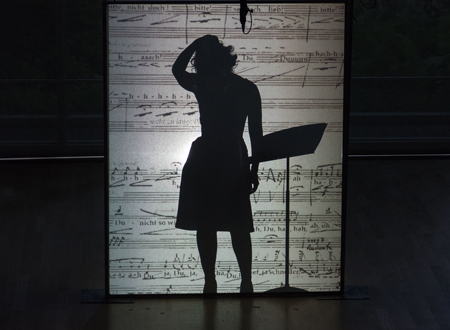by Neil McCalmont

“Obsession” began with two of Richard Wagner’s Wesendonck Lieder, his only vocal composition for which he did not also write the words. Instead, he set five poems of his patron’s wife, Mathilde Wesendonck, who was also his lover (!). He dubbed the Lieder “study pieces” for his ground-breaking opera Tristan und Isolde. Originally for voice and piano, the songs entered the repertoire as orchestrated by conductor Felix Mottl, but on Friday they were performed in an arrangement for string quartet and mezzo-soprano.
Marjorie Maltais sang “Im Treibhaus” and “Träume” with a clear, beautiful tone, joining an ensemble whose quietly nuanced playing of the chromatic writing resulted in the sound of a deep, dark “obsession.” But the arrangement didn’t sound like Wagner. It never enveloped the listener in the Bacchic frenzy that only this maximalist composer could achieve — it instead sounded like a completely different piece. What mattered is that it worked. The delicate and enjoyable performance peaked with Maltais’ third utterance of “Träume,” which really sounded like a dream.
Afterward came Leoš Janáček’s String Quartet No. 2, “Intimate Letters.” The composer had fallen in love with Kamila Stösslová — almost 40 years younger — during his old age, and his final work expresses his deepest feelings for her, as evidenced in their over 700 letters.
The piece begins with some scrupulously difficult writing, which was executed brilliantly by all members of the ensemble — their dissonances were bright and beautiful and their technical precision was flawless. The two violinists, Alexi Kenney and David Bowlin, flourished in their many moments of rapid, high-register fireworks — not a hair out of place. Bowlin was admirable in filling his role of second violinist, balancing seamlessly between supporting cast and, when Janáček permitted, star violinist. Violist Dimitri Murrath performed his solo lines with a rich, lovely sound while effortlessly ebbing and flowing with the rest of the instrumentalists (especially in the second movement). Even though the writing did not allow for cellist Julie Albers to stand out, her steady playing made her a Rock of Gibraltar. But Kenney stood out with his jaw-dropping technique, and his ability to convey how much he loved this music was an even more impressive feat.
After a warning — “FOR MATURE AUDIENCES ONLY!” — Majorie Maltais returned for Erwin Schulhoff’s Sonata Erotica for solo female vocalist. Standing behind a white screen, with lighting that revealed her silhouette, she moaned, grunted, whispered and emoted in intimate German, and made fine (and suggestive) gestures. Schulhoff’s pitch selections and breath marks were almost too realistic. After a believable “climax,” the performer invited her imaginary lover for another go-around, after which her silhouette squatted as a soundtrack of urination played in the background — a most satisfying coda. Perhaps complementary cigarettes should have been provided during intermission.
The final piece of the evening was César Franck’s Piano Quintet in f, with Bowlin and Albers joining first violinist Diana Cohen, violist Teng Li, and pianist Roman Rabinovich. Franck was rumored to have composed the piece for his composition student, Augusta Holmès, a woman not half his age. His friend Franz Liszt thought the quartet a bit too expressive for the chamber music genre, and Franck’s wife condemned the piece (and probably some of his other decisions).
The ensemble played the dissonant opening with a rich romanticism that grabbed the listener’s attention. The chords felt thick as the players produced a deep, reverberant sound. They wore their hearts on their sleeves quite convincingly: their playing was immensely compelling but never exaggerated. Cohen’s sweet sound was particularly captivating — indulgent but not overly so. The directness of the writing made the piece easy to get into, and the first movement’s recapitulation produced an infernal frenzy of sound.
The second movement was the heart-throb of the evening, and the ensemble’s lush tone transported you to a different realm. Between moments of musical floating and blissful intoxication, Li and Albers shared an especially moving dialogue. Rabinovich drove the devilish, lurking final movement home, playing with the intensity and prowess of someone who has made a pact with Mephistopheles himself.
Friday evening’s concert continued a series of ChamberFest performances that have been uniformly satisfying. Tonight the audience may well have become “obsessed.”
Photos by Gary Adams.
Published on ClevelandClassical.com June 28, 2016.
Click here for a printable copy of this article




